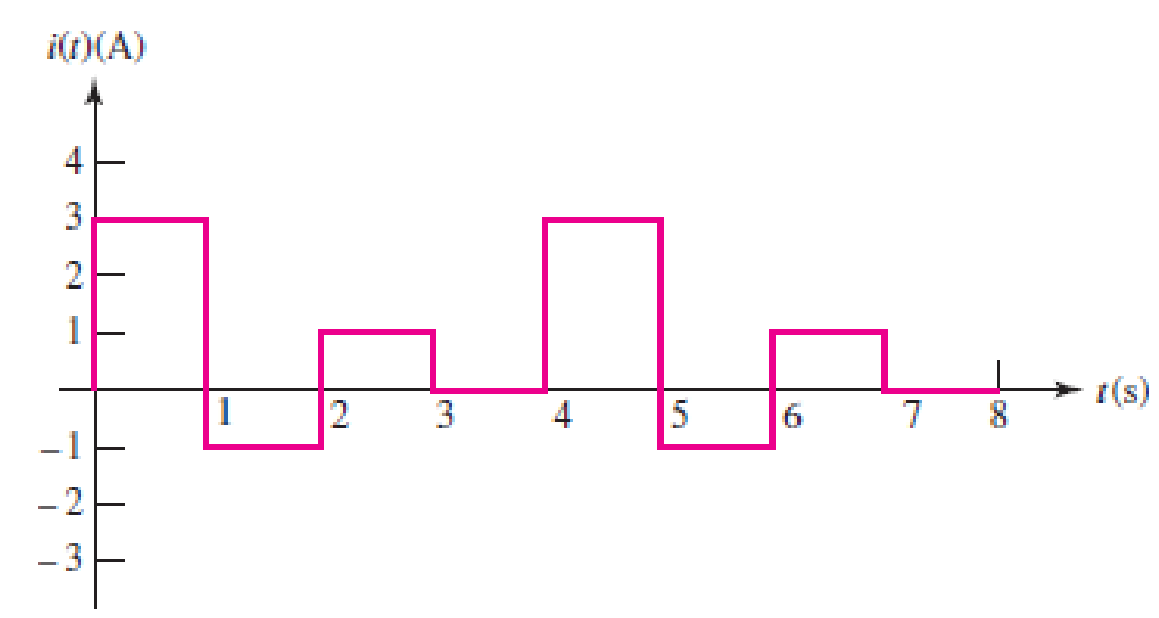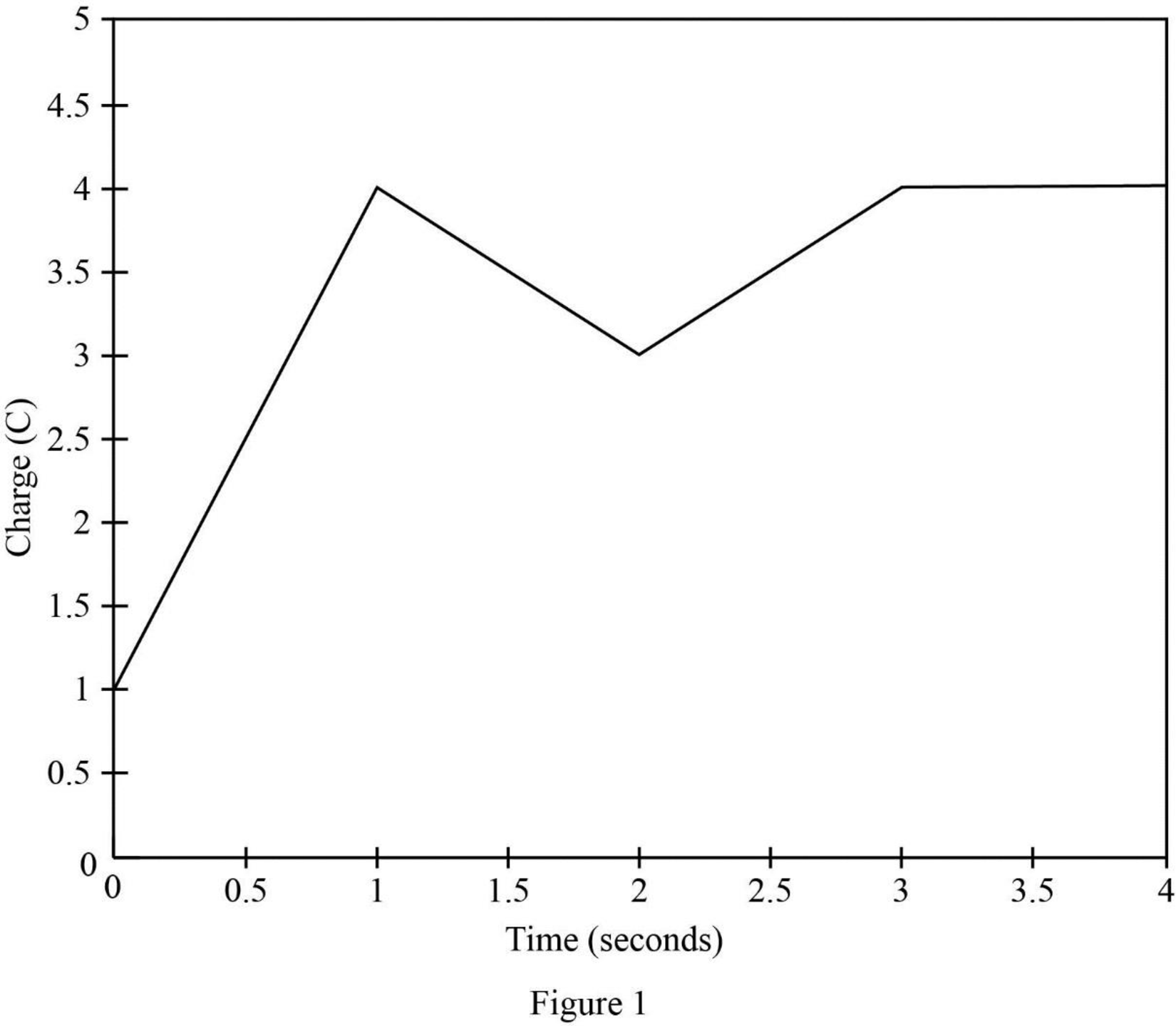
Concept explainers
The current waveform depicted in Fig. 2.29 is characterized by a period of 4 s. (a) What is the average value of the current over a single period? (b) Compute the average current over the interval 1 < t < 3 s. (c) If q(0) = 1C, sketch q(t), 0 < t < 4 s.

FIGURE 2.29 An example of a time-varying current.
(a)
Find the average value of the given current waveform in Figure 2.29 over the period of 4 s.
Answer to Problem 21E
The average value of the given current waveform over the period of 4 s is
Explanation of Solution
Given data:
Refer to Figure 2.29 in textbook for the time-varying current with the period of 4 s.
Formula used:
Write the formula to find the average value of a function of current over a period as,
Here,
T is the time period.
Calculation:
From the given current waveform in Figure 2.29, the function of current
For the period of
For the period of
For the period of
For the period of
Therefore, the final function of current
The average value of current
Reduce the equation as follows.
Conclusion:
Thus, the average value of the given current waveform over the period of 4 s is
(b)
Find the average current of the waveform over the period of
Answer to Problem 21E
The average current of the waveform over the period of
Explanation of Solution
Given data:
Refer to part (a).
Formula used:
Write the formula to find the average value of a function of current over a period of
Here,
Calculation:
Write the function of current
Now, the average current of
Conclusion:
Thus, the average current of the waveform over the period of
(c)
Sketch the waveform for the charge
Explanation of Solution
Given data:
Refer to part (a).
The initial charge
Formula used:
Write the expression for the relation between charge
Integrate the above equation on both sides.
Calculation:
Using the function of
For
Substitute 3 A for
Substitute 1 C for
Substitute 1 for
For
For the period of
Substitute –1 A for
Substitute 4 C for
Substitute 2 for
For
For the period of
Substitute 1 A for
Substitute 3 C for
Substitute 3 for
For
For the period of
Substitute 0 A for
Substitute 4 C for
Therefore, the charge
Table 1 shows for
Table 1
| t in seconds | |
| 0 | 1 |
| 1 | 4 |
| 2 | 2 |
| 3 | 4 |
| 4 | 4 |
Figure 1 shows the charge (C) vs time (s) waveform.

Conclusion:
Thus, the waveform for the charge
Want to see more full solutions like this?
Chapter 2 Solutions
Loose Leaf for Engineering Circuit Analysis Format: Loose-leaf
- A 500 W heating coil, designed to operate at 110V, it is made of 0.500mm diameter nichrome wire. a) If the resistivity of nichrome remains constant at 20.0 ° C, determine the length of the wire used. b) What will be the power given to the coil from part (a) when heated to 1200 ° C? c) If the electric company charges B/0.16 per kW-h, how much you will have to pay to keep the heating coil working at this temperature for 45 minutes?arrow_forwardcurrent of 200a is passed through a stainless-steel wire [k = 19 w/m °c] 3mm in diameter. the resistivity of the steel may be taken as 70 μω.cm, and the length of the wire is 1 m. the wire is submerged in a liquid at 110°c and experiences a convection heat transfer coefficient of 4 kw/m2 °c. calculate the center temperature of the wire.arrow_forwardThe construction of PV solar cells uses a number of critical elements. One is indium an ingredient of the transparent conducting coating on the surface of the cell. The average material intensity for indium in solar cells is approximately 0.05 kg/kWnom. Calculate the quantity of indium that would be required for a project that would provide PV solar power with capacity factor of 0.25, sufficient to meet one third of the present needs of the US, population 301 million, each using an average of 10.2 kW. The current world production of Indium is 600 tones per year. If the solar project were to be implemented over a 5 year time span, is it true that the supply of indium be adequate?arrow_forward
- A solar panel has a surface area of 0.5 m^2 and delivers maximum power at 2.5A, 19 V when in sunlight with incident radiation of 95 mW/cm^2. If the open circuit voltage is 25 V and the short circuit current is 3 A, calculate:(a) the power generated by the panel,(b) the fill factor, and(c) the efficiency of the panel. (d) Given that the solar panel is exposed to sunlight 6.5 hours per day (on average) and the energy used to manufacture the solar panel is 890 kWh/m^2, calculate the energy payback time of the solar panel.arrow_forward9. A university campus has 200 classrooms and 400 faculty offices. The classrooms are equipped with 12 fluorescent tubes, each consuming 110 W, including the electricity used by the ballasts. The faculty offices, on average, have half as many tubes. The campus is open 240 days a year. The classrooms and faculty offices are not occupied an average of 4 h a day, but the lights are kept on. If the unit cost of electricity is $0.11/kWh, determine how much the campus will save a year if the lights in the classrooms and faculty offices are turned off during unoccupied periods. Draw a figure or FBD that will support the problem. Explain each step by step formula.arrow_forwardA barangay power station supplies 60kW to a load over 2,500ft, 100 mm², two conductors copper feeder. The resistance of which is 0.0078 ohm per 1,000 ft the bus bar voltage is maintained constant at 600V. Determine the load current.arrow_forward
- A 250 V, 1.5 kW single element electric furnace is to employ a nichrome wire operating at 900°C. Estimate a suitable diameter and lengh of wire.Assume radiating efficiency = 1, emissivity=0.9, resistivity = 1.1 x 10^-6 ohm Ambient temperature = 30°C.arrow_forwardAssuming a global population of 9 billion people, each using approximately 100 W of power continuously throughout the day, calculate the total land area that would have to be set aside for photovoltaic power generation, assuming 800 W/m2 of incident solar power and a conversion efficiency (sunlight to electricity) of 10%. The total land area that would have to be set aside for photovoltaic power generation is km2.arrow_forwardKnow and be able to use the definitions of voltage and current The current at the terminals of the element isi=0,t<0;i=20e−5000t, A,t≥0;Calculate the total charge (in microcoulombs) entering the element at itsupper terminal.arrow_forward
- The resistance of a coil aluminum wire at 21OC is 210Ω. The temperature of the wire is increased and the resistance rises to 240Ω. If the coefficient of resistance of aluminum is 0 .0039/OC at 21OC, determine the temperature to which the coil has risen.arrow_forwardQuestions 1-4 relate to a battery pack for the Tesla Roadster EV consisting of 6,831 small cylindrical lithium-ion cells (18650 format). The battery pack has series-parallel arrangement: of 99 cells in series, and 69 strings (series-connected string) in parallel. Assume this battery pack is fabricated from LG 18650 cells and the LG CHEM 18650 Cell Specifications are: Nominal Voltage: 3.7V Capacity: 2800mAh Max Discharging current: 5A (continuous) Size: 18650 (Cylindrical) Length: 65 mm Diameter: 18 mm Weight: 46.5 g Retail Cost: $15.50. What is the specific energy of each cell (Wh/kg)? Q2. What is the battery pack voltage (OCV)? Q 3. What is the battery pack capacity (Ah)? Q4.What is the battery pack energy (kWh)?arrow_forwardIf the dark saturation current of a solar cell is 1.7X10-8 A/m2, the cell temperature is 27 oC, and the short-circuit current density is 250 A/m2, Vmax = 0.526 V, calculate the maximum power, Pmax; and maximum efficiency, ηmax. when the available solar radiation is 820 W/m2arrow_forward
 Introductory Circuit Analysis (13th Edition)Electrical EngineeringISBN:9780133923605Author:Robert L. BoylestadPublisher:PEARSON
Introductory Circuit Analysis (13th Edition)Electrical EngineeringISBN:9780133923605Author:Robert L. BoylestadPublisher:PEARSON Delmar's Standard Textbook Of ElectricityElectrical EngineeringISBN:9781337900348Author:Stephen L. HermanPublisher:Cengage Learning
Delmar's Standard Textbook Of ElectricityElectrical EngineeringISBN:9781337900348Author:Stephen L. HermanPublisher:Cengage Learning Programmable Logic ControllersElectrical EngineeringISBN:9780073373843Author:Frank D. PetruzellaPublisher:McGraw-Hill Education
Programmable Logic ControllersElectrical EngineeringISBN:9780073373843Author:Frank D. PetruzellaPublisher:McGraw-Hill Education Fundamentals of Electric CircuitsElectrical EngineeringISBN:9780078028229Author:Charles K Alexander, Matthew SadikuPublisher:McGraw-Hill Education
Fundamentals of Electric CircuitsElectrical EngineeringISBN:9780078028229Author:Charles K Alexander, Matthew SadikuPublisher:McGraw-Hill Education Electric Circuits. (11th Edition)Electrical EngineeringISBN:9780134746968Author:James W. Nilsson, Susan RiedelPublisher:PEARSON
Electric Circuits. (11th Edition)Electrical EngineeringISBN:9780134746968Author:James W. Nilsson, Susan RiedelPublisher:PEARSON Engineering ElectromagneticsElectrical EngineeringISBN:9780078028151Author:Hayt, William H. (william Hart), Jr, BUCK, John A.Publisher:Mcgraw-hill Education,
Engineering ElectromagneticsElectrical EngineeringISBN:9780078028151Author:Hayt, William H. (william Hart), Jr, BUCK, John A.Publisher:Mcgraw-hill Education,





